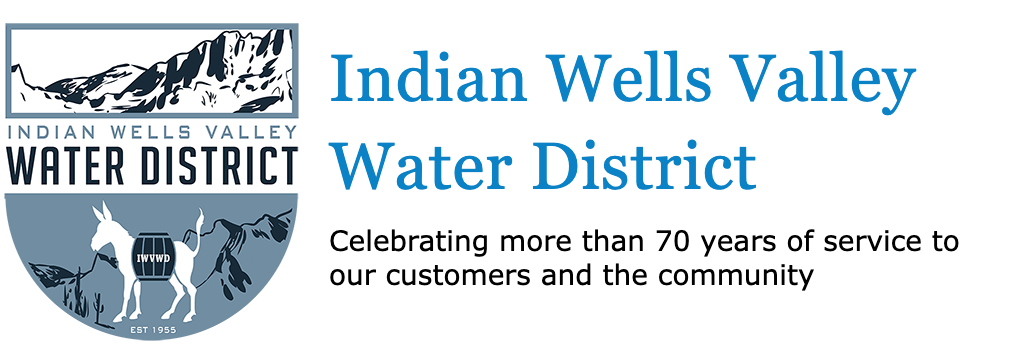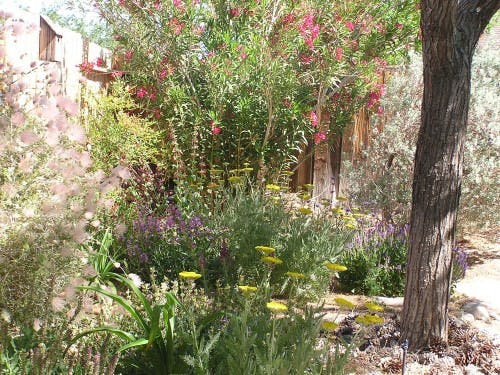FAQ | General
Who do I contact to report a water-related emergency?
Call 760-375-5086 day or night to report a water-related emergency.
After hours: Follow the prompts.
If you have a leak in your home or in your yard, immediately turn off the water either at the meter using the customer valve or at the house using the home’s master or shutoff valve.
Click Locate Your Water Shutoff Valve for more information.
Our current rates are linked below. Other charges and fees can be found in Ordinance 96 – Water Sales and Service Manual.
Ord-96-Water-Sales-and-Service-Manual-FINAL-030915.pdfAutomated metering infrastructure (“AMI”) technology is essentially a digital meter register that records usage minute by minute, and the information is electronically transmitted to the IWVWD. In addition to automated leak detection, the primary benefits of AMI include reduced staff time needed to read meters and therefore, more staff time to conduct meter-box maintenance and repair and assist customers with water audits. Automated leak detection is critical to the District’s mission to save water and avoid unexpectedly high water bills for customers by early detection of unnecessary water loss such as from running toilets, incorrectly programmed sprinkler systems and broken pipes.
Do I have to participate in the automated metering infrastructure (AMI) program?
Some IWVWD customers have expressed concerns about AMI safety* and privacy, so the District is offering the AMI Opt-Out Program. The AMI Opt-Out Program is available to any customer who chooses not to have an AMI meter installed or maintained at their home or place of business. Any customer may opt-out. However, the request must be made in writing by the IWVWD customer of record. Family members, neighbors, or landlords cannot act on behalf of another customer.
Customers can opt-out of the AMI program by submitting an opt-out form to the IWVWD District Office.
AMI-Opt-Out-Procedure-FINAL-031317.pdfThe current cost to opt-out of the AMI program is $25.00 per month. This monthly fee covers the costs to manually read your meter and manually input reads into the billing system on a monthly basis. The monthly fee will be reviewed during the cost of service process and modified as necessary to ensure the fee is adequate to cover costs. Customers may only opt-out or convert back to an AMI meter one time per service address per calendar year. If a customer elects to convert back to the AMI program, he/she will be charged the cost of the analog register, installation time, materials and a 15% administrative fee. Quotes are available upon request. Opt-out customers will not be eligible for the IWVWD Unanticipated Use Claim program.
FAQ-R900-RF-EMISSIONS-03.15.pdfOver the past few years, IWVWD water rates have increased at a higher pace than in previous years. The key reasons include new legislation requiring the arsenic treatment plants, the state’s conservation legislation, and local conservation needs.
Federal and state legislation lowered the maximum contaminant level for arsenic from 50 parts per billion to 10 parts per billion. As a result, four of the District’s wells were no longer in compliance. To mitigate the situation, the District installed two arsenic treatment plants that remove arsenic from the four affected wells. In order to finance this $15 million capital expense, the District took out a $20 million Certificate of Participation (COP). The remaining $5 million was used to refinance debt from 1999, construct a one 400,000 gallon tank to increase storage capacity, perform upgrades to Well #34, and the Water Supply Improvement Project, leaving $1.3 million for the required reserve fund. Annual debt service including principal and interest for this COP is $1.25 million, and the annual operating expense for the arsenic plants is estimated at $500,000.
In 2009, the State of California enacted SBX7 (20X2020), which requires all water agencies to reduce water usage 20% per capita by December 31, 2020. More importantly, the Indian Wells Valley is in a desert and has one source of fresh water that needs to be preserved for future generations. In order to comply with the law and to increase local water source longevity, the Board of Directors approved higher conservation rates to promote water conservation.
The District is primarily funded through water sales, so it hired an independent consultant to conduct a cost of service study to establish rates that would cover expenses. The fixed monthly Ready To Serve charge was projected to cover about 40% of fixed costs and usage rates were projected to cover the remaining fixed costs and all variable expenses. The study estimated conservation efforts would reduce usage by 4%, but actual conservation efforts reached 13%. The significant decrease in usage resulted in decreased revenues. The Board attempted to mitigate the loss by eliminating all expenses not related to the direct production of water, deferring capital and large maintenance projects, and finally reducing the workforce by 25%. Despite these changes, the revenue shortfall required an updated cost of service study. Like many other water districts in the state, the revised rate structure increased the fixed monthly Ready To Serve charge so it covered 60% of fixed costs, and it introduced a separate fixed monthly charge to cover 100% of the arsenic plant debt service and operating expenses. Lastly, the Board has implemented a revised strategy to ensure fiscal solvency, which includes having positive cash flow, balancing the budget, maintaining required reserves, and reducing debt and planning projects to avoid new debt.
In the event you feel your meter read is incorrect, please contact Customer Service right away:
Staff will promptly reread the totalizer on your meter to make sure it wasn’t misread.
You can also help determine the cause of high use. Check your automatic irrigation systems to make sure the timers are set correctly. Take meter readings at night and in the morning to calculate how much water is used while you sleep and while you’re at work. Make sure your swamp cooler pump is functioning correctly and that your toilet isn’t leaking or running.
Once the investigation is complete, if you are not satisfied, you may elect to have your meter tested for registration accuracy by a third party tester. A $75.00 deposit will be required up front.
- If the results of the test show the meter is greater than 101.5% accurate, the meter is over-reading usage, the meter will be replaced, a pro-rated adjustment will be made on previous bills up to a maximum of six months and the $75.00 deposit will be returned to the customer.
- If the meter is less than 98% accurate, meter is under-reading usage, the meter will be replaced, the $75.00 deposit will be forfeited and no further action will be taken.
- If the results of the test show that the meter is at least 98.5% to 101.5% accurate, the customer shall forfeit the $75.00 deposit to cover the District’s expense to perform the meter accuracy test.
You have various options for paying your bill. Click the link at the bottom of the page which will provide all of our options.
All charges for water furnished are due and payable when billed. To give you time to receive the bill and submit payment, the bill includes a due date, which is 15 days after the billing date.
A bill becomes delinquent 26 days after the billing date, at which time a late charge is assessed on any unpaid amounts.
- Late charge: $2.00 plus 5% of the past due amount
- 10-Day Notice of Termination letter: $6.00 per notice
- 48-Hour Notice of Termination: $13.00 per notice
- Service Reinstatement Charge (Regular hours): $38.00
- Service Reinstatement Charge (After hours): $195.00
According to California’s Government Code Sections 60370 through 60375, customers must receive two notices of termination prior to terminating service. Due to specified time requirements and billing system limitations, the District must send notices when accounts become delinquent and are subject to termination. If you received a notice in error, please contact Customer Service at 760-375-5086.
If you are unable to pay the full amount due, please come in person to the District office to discuss payment arrangements before service is terminated.
If you have already received a Notice of Termination, please come to the District office to discuss payment arrangements by the dates noted in the letter or on the door hanger.
500 W Ridgecrest Blvd
Yes! First, log into the District’s Web Payment System. Secondly, click on the My Profile tab at the top of the page or the Account Profile link located in the right hand menu. Next, scroll down to the “Your Accounts” section, and click on your account number. On the page that pops up you can select to receive a paper bill, an electronic bill, or both. Submit your new settings.
The Indian Wells Valley Water District is required to maintain a measurable level of chlorine residual in the tap water (minimum 0.2 mg/L). Some people are more sensitive to the odor or taste of chlorine than others. The causes of chlorine taste or chlorine smell are different. If there is a chlorine smell but the taste of chlorine is not evident, it is possible the water needs more chlorine. We know this sounds odd, but it is the nature of chlorine chemistry. We usually receive complaints of chlorine odor in areas where the water has become stagnant (such as dead-ends or cul-de-sacs) and the chlorine level is very low. Normally flushing the water pipes in the area to bring in fresh water solves the problem.
If the water has a distinctive taste and smell, the chlorine level may be high enough that a person finds it offensive to taste. The District chlorinates all water at the well sites. Rarely is the chlorine level above 1.0 ppm at the well; therefore, thinking your water tastes like a “swimming pool” would be incorrect. Nevertheless, if you live close to a well, the chlorine concentration in the water feeding your home may be higher than others who live further away.
If you ever feel there is an offensive taste or odor to your water, please do not hesitate to contact Customer Service at:
No. No water above the maximum contaminant level (MCL) of 10 µg/L has been served from any District well since August 1, 2011. Construction of treatment facilities that reduce the amount of arsenic in four wells was completed at that time. Some people may have been confused, though, because the District was required to send public notices to all customers regarding arsenic in the water even after the treatment facilities were completed. This is because compliance with the MCL is based on a running annual average concentration. Therefore, the District was required to continue sending notices every three months to customers until that average was reduced to below 10.5 µg/L. The last notice was mailed April 2012.
If you still have questions regarding arsenic, please call Customer Service at 760-375-5086 or send an email:
Applicants for metered and bulk rate water service shall deposit with the District an amount equal to the estimated average month water bill. View page 17 to see the Deposit Policy including deposit amounts. Security deposits will be refunded on any account that has remained in good standing for 12 consecutive months. Any security deposit on file when service is discontinued will be applied toward the final billing. For more details or if you have questions regarding a deposit, contact Customer Service at 760-375-5086.
Ord-96-Water-Sales-and-Service-Manual-FINAL-030915.pdf New Account Charge (Regular hours turn-on) $20.00
New Account Charge (After hours turn-on) $195.00
The District’s terms and conditions for water service are outlined in Ordinance 96 Water Sales and Service Policy manual.
Ord-96-Water-Sales-and-Service-Manual-FINAL-030915.pdfThe District has both mandatory and recommended watering restrictions to encourage water conservation through efficiency. The mandatory restrictions per Ordinance 100 are as follows:
“No water user shall waste water. ‘Waste’ means the following:
- During the months of April, May, June, July, August, September and October, all customers of the District (residential/commercial/public/industrial) with even-numbered addresses may only operate irrigation systems on Tuesday, Thursday and Saturday and odd numbered addresses may only operate irrigation systems on Wednesday, Friday and Sunday. Irrigation systems may not be operated on Mondays. Landscape Areas shall not be irrigated on the surface, except for hand watering and/or the use of a drip irrigation system, between the hours of 8:00 AM – 8:00 PM, unless a special permit is issued to accommodate newly planted material.
- During the months of November, December, January and February, all customers of the District (residential/commercial/public/industrial) with even-numbered addresses may only operate irrigation systems on Saturday and odd numbered addresses may only operate irrigation systems on Sunday. Irrigation systems may not be operated on Mondays, Tuesdays, Wednesdays, Thursdays or Fridays. There will be no daytime watering restriction during these months.
- Landscape irrigation to an extent which allows water to runoff the area being irrigated, specifically onto sidewalks and streets creating an undue, continuous flow of water.
- Washing down hard or paved surfaces, including but not limited to sidewalks, walkways, driveways, parking areas, tennis courts, patios or alleys, is prohibited except when necessary to alleviate safety or sanitary hazards, and then only by use of hand-held bucket or similar container, a hand-held hose equipped with a positive self-closing water shut-off device or a low-volume water broom, high-pressure cleaning machine equipped to recycle any water used. General maintenance cleaning shall be performed by other means such as by using a broom.
- Knowingly allowing water to leak through water connections, hoses, faucets, pipes, outlets or plumbing fixtures.
- Limits on washing vehicles: Using water to wash or clean a vehicle, including but not limited to any automobile, truck, van, bus, motorcycle, boat, motor home, or trailer, whether motorized or not is prohibited, except by use of a hand-held bucket or similar container or a hand-held hose equipped with a positive self-closing water shut-off nozzle or device. This subsection does not apply to any commercial car washing facility that recycles water.
- No water shall be provided to any structure hereafter constructed or remodeled unless the plumbing fixtures to be installed conform to requirements of law as to flow capacity.”
- Turf or ornamental landscapes shall not be irrigated during the 48 hours following measurable precipitation.
- Restaurants and other food service establishments shall only serve water to customers on their request.
- Operators of hotels and motels shall provide guests with the option of choosing not to have towels and linens laundered daily and prominently display notice of this option.
- Operating a fountain or decorative water feature is prohibited, unless the water is part of a recirculating system.
- No water service shall be provided to any structure hereafter constructed or remodeled unless the plumbing fixtures to be installed conform to requirements of law as to flow capacity.
Download Ordinance 100 – Water Efficient Landscape Ordinance.
Ordinance-No-100.pdfThe District is 38 square miles. For specific details, check out our District Boundary Map.
DistrictBoundaryMap.pdf
I have a question that wasn’t included here…
Please fill out the form below!




.jpg?ixlib=rb-1.1.0&or=0&w=720&h=720&fit=max&auto=format%2Ccompress&s=a192504731ca8a4023291373f875eca3)



